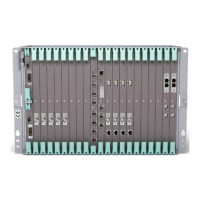Technical Description
Alarm notifications can be enabled/disabled for an entire NE, for an individual
plug-in unit and for individual interfaces. Disabling alarm notification means that
no new alarms or event notifications are sent to the management systems.
Alarm and event notifications are sent as SNMP v2c/v3 traps with a format
according to Ericsson’s Alarm IRP SNMP solution set version 1.2. The following
fields are included in such a notification:
• Notification identifier: uniquely identifies each notification.
• Alarm identifier: only applicable for alarms, identifies all alarm notifications
that relate to the same alarm.
• Managed object class: identifies the type of the source (E1, VC-4 etc).
• Managed object instance: identifies the instance of the source like 1/11/1A
for an E1 on the NPU.
• Event time: time when alarm/event was generated.
• Event type: X.73x compliant alarm/event type like communications alarm
and equipment alarm.
• Probable cause: M.3100 and X.733 compliant probable cause, for example
Loss Of Signal (LOS).
• Perceived severity: X.733 compliant severity, for example critical or
warning.
• Specific problem: free text string detailing the probable cause.
The system can also be configured to send SNMP v1 traps. These traps are
translated from the IRP format using co-existence rules for v1 and v2/v3 traps
(RFC 2576).
For a full description of alarms see user documentation.
5.1.2 Loops
Loops can be used to verify that the transmission system is working properly or
they can be used to locate a faulty unit or interface. The following loops are
available on all units that carry traffic.
Connection
Loop
This loop can be initiated for an E1. The traffic connection
is looped in the TDM bus back to its origin, see Figure 82
on page 108. If an E1 interface is traffic routed an AIS is
sent to the other interface in the traffic routing.
A Connection Loop can be used in combination with
a BERT in another NE to test a network connection
including the termination plug-in unit, in case a Local
Loop cannot be used due to the lack of a traffic routing.
106
12/221 02-CSH 109 32/1-V1 Uen A 2008-03-14

